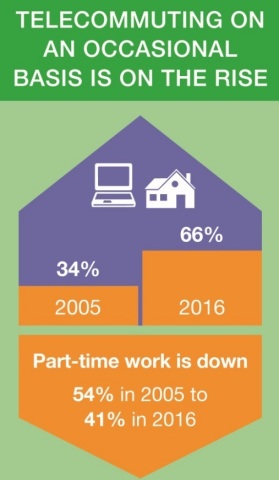ALEXANDRIA, Va.--(BUSINESS WIRE)--Despite reports from well-known companies that they have expanded their paid-leave benefits, the average amount of parental and caregiving leave provided by U.S. employers has not changed significantly since 2012, the National Study of Employers has found.
The comprehensive study of how employers are responding to the changing workforce was designed and conducted by the Families and Work Institute (FWI) and released today by the Society for Human Resource Management (SHRM).
When Netflix, Amazon, Microsoft, Johnson & Johnson, Ernst & Young and others announced that they were expanding their parental leave, it appeared that a trend had begun. But the study found otherwise, said Ellen Galinsky, president and co-founder of FWI and an author of the study.
“Whether high-profile companies offering paid leave are out of step with the majority of employers or leading the way remains to be seen,” said Galinsky, who also is a senior research advisor at SHRM. “Given our findings that 78 percent of employers reported difficulty in recruiting employees for highly skilled jobs and 38 percent reported difficulty in recruiting for entry-level, hourly jobs, these high-profile companies could be leading the way.”
The maximum length of paid or unpaid parental and caregiving leave was recorded in 2005. Since then, maternity, paternity, adoption and caregiving leave have all declined. Today, the average maximum number of weeks of maternity leave is 14 ½, and a little more than 11 weeks is the average leave for a spouse/partner (paternity leave).
Over the past 11 years, the number of organizations offering at least some replacement pay for women on maternity leave has increased 12 percentage points, from 46 percent to 58 percent, Galinsky noted. But the study also found that, among employers offering any replacement pay, the percentage offering full pay has continued to decline from 17 percent in 2005 to 10 percent in 2016.
Telework is another workplace flexibility arrangement that has been in the news in the last two years. Despite several big-name companies dropping their telecommuting options, 40 percent of employers allow employees to work some of their paid hours at home on a regular basis, up from 33 percent in 2012, the study found.
Changes Seen in Workplace Practices
Of the 18 forms of flexibility the study assessed, there were few changes between 2012 and 2016, representing a pause in the growth of flexibility.
But, in addition to the increase in regular work at home, two forms of flexibility have increased:
- The percentage of employers allowing employees to return to work gradually after the birth of a child or adoption (from 73 percent in 2012 to 81 percent in 2016).
- The percentage of employers allowing employees to receive special consideration after a career break for personal/family responsibilities (from 21 percent in 2012 to 28 percent in 2016).
One form of flexibility decreased during this time: the percentage of employers allowing employees to take time off during the workday to attend to important family or personal needs without loss of pay, which declined from 87 percent in 2012 to 81 percent in 2016.
“While more employers are being supportive in how employees return from parental and caregiving leave, there is less support for flexibility during the workday,” Galinsky said. “What people need most is time off during the day, and fewer are getting it.”
A surprising finding that may have contributed to the pause in flexibility was a dramatic drop in management rewarding support for flexible work arrangements — from 31 percent in 2005 to 14 percent in 2016. “This is worrisome,” Galinsky said, “because having policies is not enough. Without management support, employees can’t use policies. This suggests the need for more training for supervisors and others who manage employees.”
Methodology: The National Study of Employers surveyed a representative national sample of 920 for-profit and nonprofit employers in the United States with 50 or more employees through telephone interviews and online surveys with human resource directors. Conducted by Harris Poll between September 2015 and February 2016, the survey has a margin of error of plus or minus 3.23 percentage points.
To download a copy of the report, visit https://www.shrm.org/hr-today/trends-and-forecasting/research-and-surveys/Pages/National-Study-of-Employers.aspx
About the Society for Human Resource Management
The Society for Human Resource Management (SHRM) is the world’s largest HR professional society, representing 285,000 members in more than 165 countries. For nearly seven decades, the Society has been the leading provider of resources serving the needs of HR professionals and advancing the practice of human resource management. SHRM has more than 575 affiliated chapters within the United States and subsidiary offices in China, India and United Arab Emirates. Visit us at shrm.org and follow us on Twitter and Instagram @SHRMPress.




